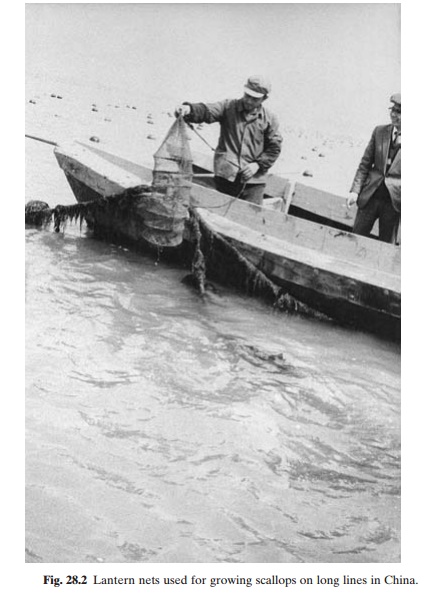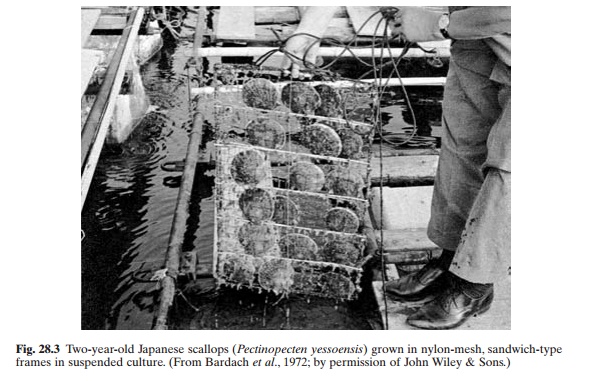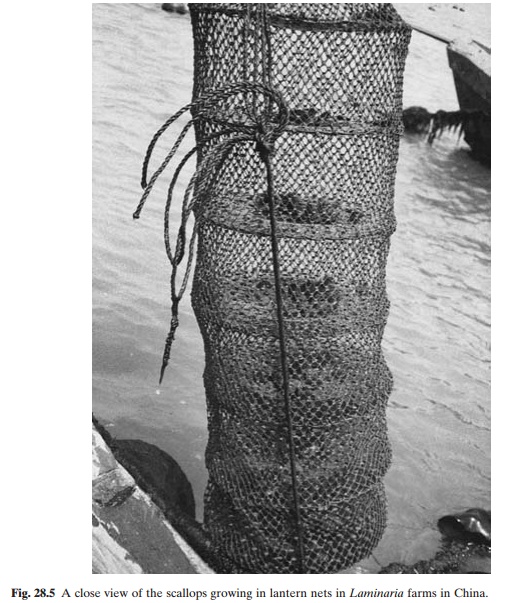Chapter: Aquaculture Principles and Practices: Clams, Scallops and Abalones
Scallops
Scallops
Scallops form another group of bivalve molluscs of considerable importance in the seafood industry. Declining landings from natural beds have aroused interest in increasing production through application of aquaculture techniques. Though significant research on the biology of a number of species of scallops has been done in many countries, commercial-scale culture is limited to only a few, mainly Japan and ChinaThe most important species in Japan is the deep-sea scallop or the giant ezo scallopPatinopecten yessoensis and the most important onein China is Chlamys farreri. Commercial culture of a larger species, C. nobilis, has been started in recent years in some areas of southern China. In the USA, the bay scallop Argopecten irradians has been spawned inhatcheries and the seed grown to market size in pens (Castagna, 1975). The giant scallop, Placopecten magellanicus, has also been investigated in terms of its potential for farming.
Though many species seem to prefer fairly hard substrates with little mud in coastal zones, the European tiger scallop, Chlamys tigerina, prefers coarse sandy mud, gravel or stones. The European king scallop, Pectinopecten maximus, prefers bottoms of clean firm sand, fine gravel or sandy gravel. The feeding habits of scallops are very similar to those of other bivalves and the main components of food are reported to be diatoms, protozoa and considerable amounts of detritus. The deep-sea scallops show abnormally high levels of fecundity and a fully grown four-year-old is capable of producing 160 million eggs. The sexes are separate, although hermaphrodites may sometimes be found. In Japan this species spawns between March and July, depending on the location.
The systems of culture adopted for experimental and commercial production of scallops are very similar to those used for other bivalves. Early efforts involved the collection of seed scallops and their planting in either depleted beds or in areas suited for rapid growth. This led to the next stage of rearing the seed in cages or ponds and releasing them in natural beds after they had grown to a shell length of about 3mm, to improve survival rates. The present trend is to raise the seed to market size using suspended systems. In China, scallops are often cultured in association with seaweed in fore-shore areas, in lantern or pearl nets suspended from long lines.
Spat collection
A variety of substrates have been used for collecting seed scallops. The traditional collectors, like cedar leaves and scallop shells, have been replaced in Japan by polyethylene-mesh bags attached to long-line systems. The long linesvary in length from 50 to 100m and the number of bags attached to each line depends on the water depth and the number of branch lines. The bags are filled with artificial substrates such as mesh monofilament, soft netlon, nylon and plastic meshes and rubberized fibre. Any substrate with a clean surface can be used for collecting seed of the European scallops C.maximus and C. opercularis. The mesh size ofthe bag depends on the local conditions including the silt load in the area. The mesh is selected with a view to facilitating free water flow, at the same time preventing the escape of the settled spat and clogging of the meshes by silt. The collectors are laid out at times of spatfall, which are forecast on the basis of close monitoring of water temperature, spawning and larval abundance.
Hatchery production of spat
As in the case of oysters, mature scallops can be induced to spawn by thermal shock and larvae are grown in hatcheries by techniques similar to those for other bivalves. However, this method of seed production has not become very widespread because of the easy availability of natural seed. On the other hand, most of the seed used in culture of C. farreri and C.nobilis in China are reported to be hatchery-produced. In North America, too, the trend is to use hatchery-produced spat.
Sexually mature adults can be induced to spawn by increases in temperature and by the addition of milt from mature males in spawning tanks. Most species of scallop can be spawned by temperature shock, when properly conditioned brood stock are used. The bay scallop, A. irradians, the Chilean scallop, A. purpuratus, the deep sea scallop,P. yessoensis, andthe Chinese scallops mentioned above have all been spawned in hatcheries by this method. Other stimuli which can be used are ultra-violet rays and hydrogen peroxide in very low concentrations.
Scallops show high fecundity, for example a fully mature P. yessoensis can produce at least
100 million eggs. In spawning hermaphrodite individuals, care has to be taken to avoid polyspermy by collecting the sperm and eggs in separate containers and then artificially fertilizing the eggs. Fertilization can be achieved by adding 2–6ml sperm suspension for every litre of egg suspension. Embryonic development is rapid and free-swimming trochophores can be obtained in 8–24 hours, depending on water temperature. The optimum temperature for the development of the bay scallop is reported to be 26–28°C and gentle aeration and frequent water exchange are usually maintained in the tanks. The larvae are fed on phytoplanktonic organisms such as Monochrysis, Chaetoceros,Isochrysis, Phaeodactylum, Dunaliella and Tetraselmis. The larvae normally settle withintwo weeks.
Grow-out
The simplest system of grow-out is by planting in suitable beds. The spat are released from boats during the summer months. The density of spat depends on local conditions, but five or six per m2 is considered suitable for obtaining a commercial size of five or six per kg. The survival rate is only about 25–30 per cent. Even in hanging culture, more widely practised now, the mortality rates are high and so a two-phase system of grow-out has been recommended. In the first phase, the spat are grown in pearl nets or lantern nets on long lines (fig. 28.2) until they develop harder shells.

Long lines used for early grow-out are usually longer than those used for spat collection, and may be as long as 200m. Pearl nets hung from the long lines are conical or pyramidal in shape (fig. 28.3), made of small-mesh (2–7mm) net, and provide adequate protection to the spat from predators and silt deposition. Free circulation of water is ensured. The maximum number of spat in each net is about 100 and the nets are hung at 2–12m depth of water. As the growth rate of the spat is rather rapid, the stock has to be thinned out at regular intervals and transferred to new nets.

The traditional Japanese method of grow-out to market size consists of hanging seed scallops on long lines, sometimes referred to as the ‘ear hanging’ method. Small holes are drilled on the anterior side of the ear of each seed scallop(about 2mm in size), threaded with nylon and tied to ropes for hanging on long lines (fig. 28.4).

Most modern hanging culture facilities use long-line systems and rafts.
While long lines can be used in shallow inshore areas, as well as offshore deep areas, rafts are only suitable for protected areas. In inshore waters, simple long lines of about 50–60m length are used, whereas more complicated systems of long lines of
100–480m length, with several branch lines, are used in deeper areas. Using such large long-line systems, as many as half a million scallops are reported to be cultured in an area of 9ha in sites exposed to strong wave action and wind during winter months. Spat with hardened shells are placed in lantern nets (known also as Adnon baskets) and hung from the long-line system. The lantern nets are made of mono-filament netting (of about 12–25mm mesh), supported by plastic-coated or galvanized wire hoops of about 50cm diameter which divide the net into several compartments of about 15cm height (fig. 28.5). Each compartment has a lateral opening through which scallops can be introduced or removed.

The stocking density determines the growth rate and a density of 20 scallops per compartment is reported to give good results. These nets are suspended by nylon ropes.
An old system of growing scallops in suspended ‘pocket nets’ is still practised in someareas of Japan. This type of net is made of polyethylene-mesh attached to a framework (usually 140cm high and 45cm wide) made of plastic-coated or galvanized wire. A series of pockets are stitched on the mesh at different levels. Seed scallops are placed in the pockets which are closed by tying with nylon yarn. The net is hung in the water by means of nylon ropes.
It normally takes two to three years for the seed scallops to grow to market size, which for the deep-sea scallop in Japan is 10–11cm in length.
At temperatures between 12 and 20°C, the Chinese species of scallops reach marketable size in 1.5–2 years. Floating racks and plastic mesh cages are used for grow-out and many growers rear scallops and the seaweed Laminaria in the same site, as it increases the totalproduction and income from the same area.The market size for C. farreri is about 6–7cm and for C. nobilis it is 7cm length.
Related Topics